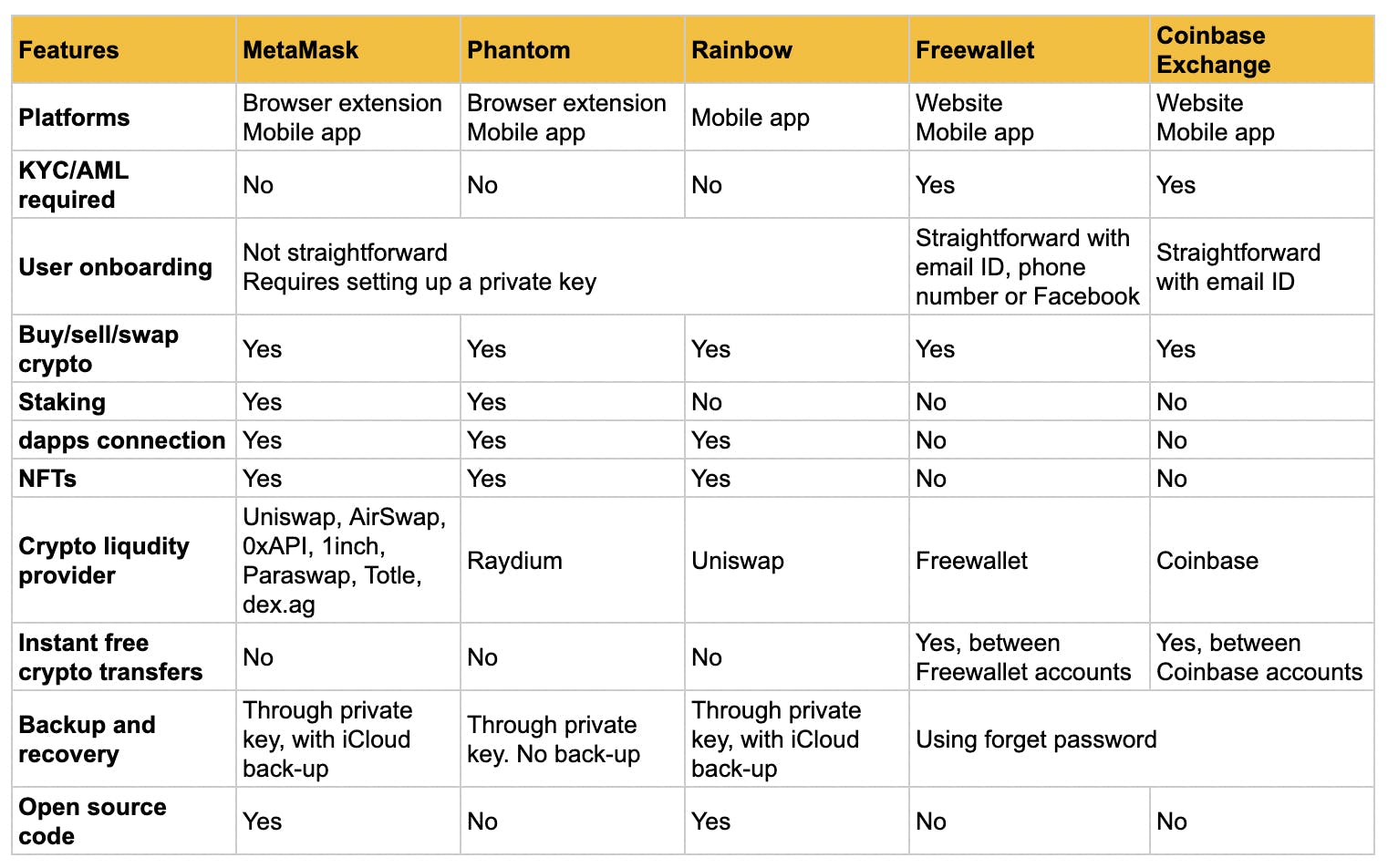
Rohit Kaul
Research at Sacra
A crypto wallet is an app or a physical device that allows users to store, send and receive their crypto assets. It consists of a key pair: A public key that’s the digital address of the wallet to send/receive crypto and a private key that’s like a password to access the wallet. There are two types of wallets, depending on who manages the private key.
These are the most convenient way to set up crypto wallets, predominantly used by new crypto users. When you buy crypto using an exchange, the crypto is automatically stored in a custodial wallet. The main benefit is that the wallet provider manages the private key behind the scenes. So you don’t have to worry about getting locked out of your crypto if you can’t remember it.
The key drawback is that the custody of your crypto is with the wallet provider. So you can be deplatformed and lose access to your crypto. Moreover, your crypto’s security depends entirely on the security measures taken by the wallet provider. Custodial wallets can’t access many crypto applications such as NFT marketplaces, play-to-earn games, and tokenized social media.
Custodial wallets make money by charging a transaction fee, which could be a spread on buying or selling transactions.
For non-custodial wallets, you are responsible for managing and keeping the private key safe. The obvious benefits are that these wallets are more secure and allow you to move your crypto to any wallet provider using your private key.
The key drawback is that if you lose the private key, the wallet provider cannot reset it for you, and there’s no way to access your crypto. These wallets allow you to access more crypto applications such as staking, purchasing NFTs, and play-to-earn games.
Non-custodial wallets can be web applications, desktop/mobile applications, or a physical device such as a pen drive.
Non-custodial wallets make money by charging a transaction fee on crypto swaps when one crypto is exchanged for another. Hardware wallets charge separately for the physical device.
Some tailwinds support the sustained growth of custodial wallets.
Crypto exchanges drive custodial wallets’ growth
Crypto exchanges such as Coinbase, FTX, and Binance are growing rapidly as many new users get into the crypto ecosystem to make money by buying and selling crypto. Coinbase exchange’s user accounts grew 2X in 2021 to reach 89M. FTX’s user base grew 15X in 2021 to reach 5M.
Familiar user experience
Custodial wallets are popular because they make buying and selling crypto convenient, with user experience similar to a digital bank. In comparison, new users find the UX of non-custodial wallets complex. For instance, the onboarding process prompts them to save and not lose the 12-word private key, which is unnerving. An email address or a phone number is insufficient for signing up for a non-custodial wallet.
Lower fees
Some custodial wallets offer free on-platform transactions by not registering them on the blockchain. For instance, users of Freewallet (custodial) saved $500,000 in one year for inter-Freewallet transactions. This is not possible for non-custodial wallets.
Non-custodial wallets are gaining traction, driven by these tailwinds.
Gateway to decentralized apps
Decentralized apps (dapps) such as NFT marketplaces, play-to-earn games, and tokenized social networks have become popular in the last 2 years. Dapps connect with non-custodial wallets to authenticate users and use the stored crypto for transactions. For instance, users store earned crypto from Axie Infinity (a play-to-earn game) in their wallet, use it to buy NFT on OpenSea (NFT marketplace), and keep the NFT safe in their wallets. Thus, the wallets become the hub for using dapps.
Browser extensions and mobile apps
The availability of non-custodial wallets as browser extensions and mobile apps is helping their growth. MetaMask’s MAU grew 6X in just 12 months to reach 32M in April 2022. In just six months, another non-custodial wallet Phantom grew from no users to 2M MAU. Large exchanges such as Binance and Coinbase have also launched non-custodial wallets to cater to evolved users.
Risk of deplatforming in custodial wallets
Custodial wallets can ban users and lock them out of their crypto assets. Recent user blocking events during the Russia-Ukraine war and trucker strike in Canada show that this is a real risk.
Features
Key metrics
Funds raised
Features
Key metrics
Funds raised
Features
Key metrics
Funds raised
Features
Key metrics
Funds raised
Features
Key metrics
Funds raised

Suite of developer tools and wallets for building and using Ethereum-based applications